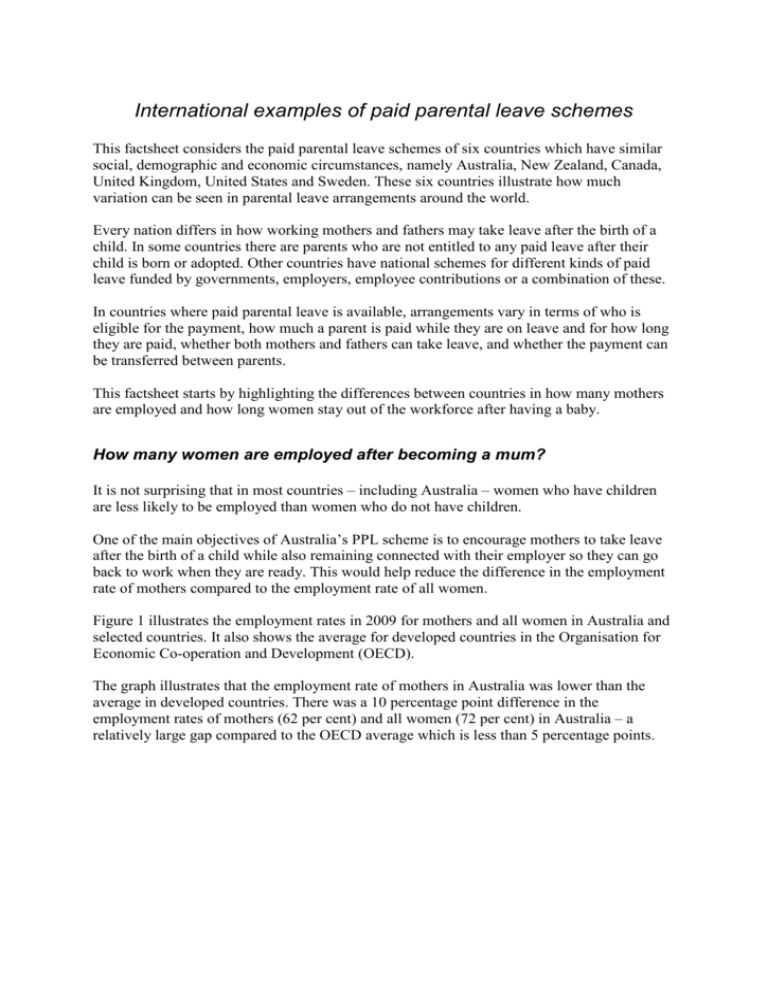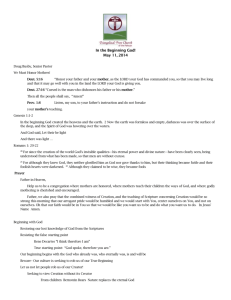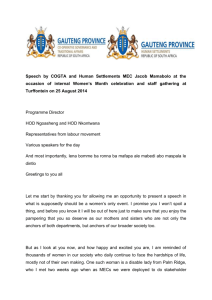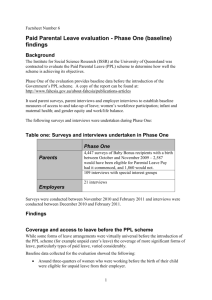International examples of paid parental leave schemes
advertisement

International examples of paid parental leave schemes This factsheet considers the paid parental leave schemes of six countries which have similar social, demographic and economic circumstances, namely Australia, New Zealand, Canada, United Kingdom, United States and Sweden. These six countries illustrate how much variation can be seen in parental leave arrangements around the world. Every nation differs in how working mothers and fathers may take leave after the birth of a child. In some countries there are parents who are not entitled to any paid leave after their child is born or adopted. Other countries have national schemes for different kinds of paid leave funded by governments, employers, employee contributions or a combination of these. In countries where paid parental leave is available, arrangements vary in terms of who is eligible for the payment, how much a parent is paid while they are on leave and for how long they are paid, whether both mothers and fathers can take leave, and whether the payment can be transferred between parents. This factsheet starts by highlighting the differences between countries in how many mothers are employed and how long women stay out of the workforce after having a baby. How many women are employed after becoming a mum? It is not surprising that in most countries – including Australia – women who have children are less likely to be employed than women who do not have children. One of the main objectives of Australia’s PPL scheme is to encourage mothers to take leave after the birth of a child while also remaining connected with their employer so they can go back to work when they are ready. This would help reduce the difference in the employment rate of mothers compared to the employment rate of all women. Figure 1 illustrates the employment rates in 2009 for mothers and all women in Australia and selected countries. It also shows the average for developed countries in the Organisation for Economic Co-operation and Development (OECD). The graph illustrates that the employment rate of mothers in Australia was lower than the average in developed countries. There was a 10 percentage point difference in the employment rates of mothers (62 per cent) and all women (72 per cent) in Australia – a relatively large gap compared to the OECD average which is less than 5 percentage points. Figure 1: Employment rates for mothers with a child under 15 years and all females (25-54 years), 2009 i 100 90 80 70 60 50 Females 40 Mothers 30 20 10 0 Sweden Canada United Kingdom United States New Zealand Australia OECD average The relationship between birth rates and employment rates We know that mothers have a lower rate of employment than women overall. It follows that countries with high birth rates – in other words, countries where there are more babies per woman – would have fewer females in the workforce. But this is not the whole story. Birth rates, female employment rates, and the interaction between birth rates and employment, vary considerably between countries as illustrated in Figure 2. The most stark contrast in Figure 2 is the difference between Sweden and the USA. Although these two countries have a similar birth rate (approximately two babies per woman) the female employment rate in Sweden (82 per cent) is much higher than in the USA (69 per cent). This suggests women in Sweden are more likely to stay in the workforce after they have a baby than women in the USA. In Figure 2, Australia is similar to the USA, New Zealand and Great Britain. Compared to all the other developed countries in the OECD these countries have high birth rates and moderately high female employment rates. Figure 2: Female employment rates and national birth rate for selected countries ii Female employment rate 84 82 80 Australia 78 Canada 76 New Zealand 74 Sweden 72 Great Britain 70 USA 68 1.0 1.5 2.0 2.5 Total birth rate How old are children when mothers go back to work? In many developed countries the majority of mothers are employed when their youngest child is three years old and in most countries the majority are at work by the time their child is five years old – around school age. Figure 3 shows maternal employment rates in the selected countries, comparing mothers whose youngest child is aged less that 5 years to mothers whose youngest child is aged 6-14 years. Mothers in Australia tend to return to work when their children are older. The employment rate of mothers in Australia whose youngest child is five years old is just under 50 per cent, which is less than the OECD average of 64 per cent. In contrast, the majority of mothers in Sweden (81 per cent) have returned to work by the time their child is 5 years old. The employment rate of mothers in Australia whose youngest child is 6-14 years old is similar to the OECD average (74 and 73 per cent respectively). Figure 3: Employment rates of mothers by age of youngest child, 2009 iii 90 80 70 60 50 0-5 years 40 6-14 years 30 20 10 0 Sweden Canada OECD average United States New United Australia Zealand Kingdom The trends described above highlight how females in different countries have different patterns of employment after the birth of a child. There are a number of reasons for this variation including economic factors (eg. average family income, cost of living, availability of suitable jobs), cultural preferences, demographic differences (eg. average age of mothers, education) and other social trends which influence families and working life in different countries. Government policies influence if and how mothers participate in the workforce with policies about parental leave as well as other issues such as job security, wages, taxation, flexible working conditions, equal employment opportunities, early childhood services and school. How do government parental leave policies vary between countries? There is a great deal of variation in parental leave policy of governments around the world. The policies specify whether parents are guaranteed parental leave, and if so, who is eligible. Policies on paid parental leave vary in terms of the duration of leave, the payment amount, the eligibility requirements, and whether the government or employer makes the payment. The following table presents an overview of paid parental leave schemes in selected countries. Overview of parental leave arrangements in Australia and selected countries4 What is the maximum amount of time mothers are entitled to unpaid leave? 5 Australia US UK What is the maximum amount of time mothers are entitled to paid leave from a national scheme? 52 weeks + additional 52 weeks if employer agrees 18 weeks 12 weeks No legislated entitlement 52 weeks 39 weeks What is the payment rate? What is the maximum weekly amount mothers may receive (approximate)? Who pays for the parental leave? Does the employer make the payment? Can some of the paid leave be transferred to fathers or partners? Are fathers and partners entitled to post-birth paid leave? Government funded 2 weeks Australian dollars National Weekly Minimum Wage $606 + $606 + 90% of mother’s average weekly earnings for at least 6 weeks Not capped for 6 weeks then capped at GBP £137 for remaining 33 weeks $211 33wk cap Government funded 2 weeks Canada 52 weeks 50 weeks 55% of average insured earnings CAD $501 $497 Employee and employer contributions; shortfalls covered by Government NZ 52 weeks 14 weeks 100% of ordinary weekly pay or average weekly earnings NZD $475 $394 Government funded ~60 weeks 80% of earnings for 47 weeks; remaining 13 weeks at SEK kr1260 a week $991 Employer contributions; shortfall covered by Government 10 days Sweden ~77 weeks SEK kr6545 during first 47 weeks i This chart compares maternal employment rates (mothers with a child under 15) with female employment rates (25-54 year old females). Sources: European countries: European Union Labour Force Surveys (EULFS) (2009-10); Sweden: EULFS-Eurostat database; Australia: Australian Bureau of Statistics Labour Force Survey (2009); Canada: Statistics Canada (2001); New Zealand: New Zealand Household Labour Force Survey – June quarter (2009); United States: US Current Population Survey (2005). ii Sources: Employment rates: OECD Employment Outlook United Nations World Statistics Pocketbook, 2010. Fertility rates: National Statistical Offices 2010 and Eurostat Demographic Statistics, 2010; data for Canada is from 2009. iii Sources: European countries: European Union Labour Force Surveys (EULFS) (1999-2010); data for Sweden is from 2007; Australia: Australian Bureau of Statistics Labour Force Survey (2009); Canada: Statistics Canada (2001); New Zealand: New Zealand Household Labour Force Survey - June quarter (2009); United States: US Current Population Survey (2005). Data for ‘6-14 years’ group for Canada, Sweden and the United States refer to mothers with a youngest child aged between 6 and 16. 4 Sources: GOV.UK (www.gov.uk); Service Canada, (www.servicecanada.gc.ca); New Zealand Ministry of Business, Innovation and Employment (www.dol.govt.nz) and Försäkringskassan (Swedish Social Insurance Agency) (www.försäkringskassan.se). Reserve Bank of Australia exchange rates (15 May 2013). 5 This includes paid leave period.







